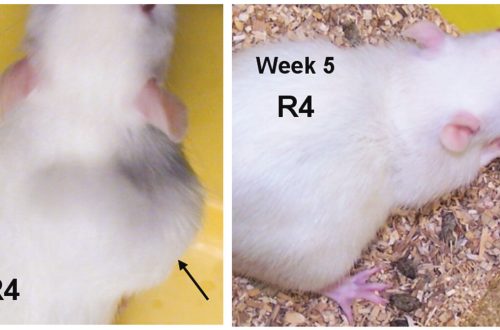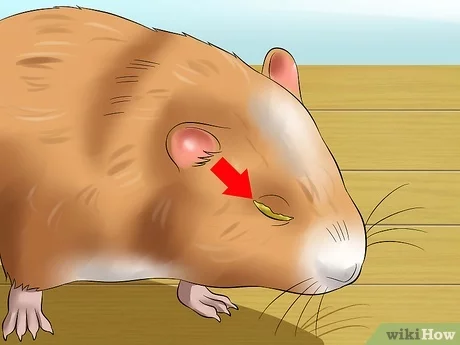
The hamster’s eyes do not open (or fester): what to do at home
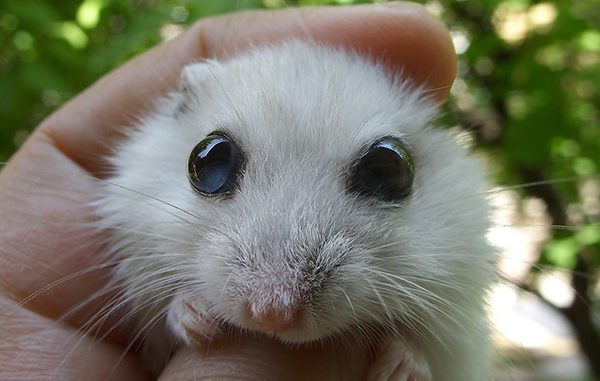
Due to the natural characteristics of eye diseases in hamsters, they are very common. The owner should be able to provide first aid to the pet and imagine what to do if the hamster’s eyes do not open.
The eyes of nocturnal rodents are large and convex, which gives them a charming appearance, and allows you to spot a predator in time. But physiological exophthalmos (bulging eyes) significantly reduces the protection of the organ of vision. A hamster can easily injure it or prick it due to a delayed blinking reaction. The central zone of the cornea is poorly washed with tears, wetted little, so even a minor injury can lead to an ulcer. Hamsters are active at night and are not adapted to bright light. A bright flash or direct sunlight can damage hamsters’ eyesight, which is already weak.
Due to the pet’s small size and independent nature, the owner often finds the problem at an advanced stage: the hamster has one eye closed, or both eyelids are glued with pus, one is larger than the other, and so on.
Contents
Injuries
Little pets are forbidden to run around the apartment without a special ball for a reason. Animals can be injured, even while in a cage, including damage to the organ of vision. The injury is characterized by damage to one eye. A hamster can get hurt in a fight while keeping animals together, or stumble upon a sharp straw in the hay.
Corneal injury
When the damage is fresh, it is difficult to understand what is the matter: the hamster has a watery eye, he squints, does not let you see if the eye is reddened. The animal cannot tell about it, but after the injury, the eye hurts a lot. Behavior changes due to pain: the pet becomes nervous, inactive, hides. When the cornea or other structures are injured, a secondary infection quickly accumulates, pus appears. The eye turns sour, and the problem becomes obvious.
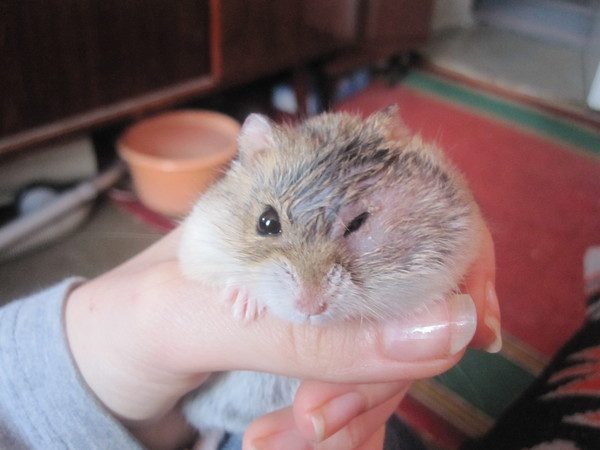
When a hamster’s eye fester and does not open, you must first clean the eyelids for inspection. Do not use liquids that are not safe for the mucous membrane of the eye, such as hydrogen peroxide. If the eyes are stuck together, the eyelids are not separated by force, but patiently soaked. The best harmless remedy is warm saline or boiled water.
Use a sterile gauze swab or cotton pad. You can not take ordinary cotton wool: small fibers remain on the eyelids and eyelashes, causing irritation. In order not to carry the infection, you need separate tampons, at least two.
When a scratch heals on the cornea, a scar can form, then a white spot is noticed on the hamster’s eye.
Sometimes, after removal of pus and examination, the wound is found on the eyelid, and the eye itself is unharmed. Then an antibiotic eye ointment (Tetracycline) is applied to the wound twice a day. Do not use regular ointment.
Abscess
In addition to injury, a localized abscess known as stye may develop on the eyelids. An abscess may look like a pimple, a seal on the edge of the eyelid. There is redness and soreness. After the bump opens, the pus flows out and recovery occurs. If the hamster’s eye aches, instill antibacterial drops or apply an ointment. You can open a mature abscess with a sterile needle to speed up the process.
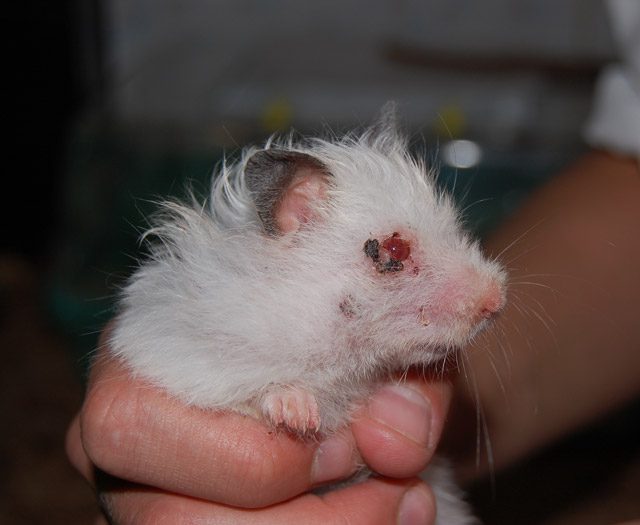
blunt trauma
If the animal is accidentally crushed, as well as when falling from hands or furniture, blunt eye injury is possible, accompanied by damage to the structures of the organ of vision and hemorrhage. A few hours after the accident, the blood settles and the eye looks red. Hemophthalmos (blood in the vitreous) accompanied by loss of vision.
At home, it is not possible to establish how badly the pet has damaged its eye, but if the hamster’s eye popped out after a fall, the prognosis is poor. First aid is cold (a napkin soaked in saline) and an antibacterial ointment that will prevent the cornea from drying out if the hamster has swollen eyes so that the animal cannot close its eyelids.
Conjunctivitis
Inflammation of the mucous membrane of the eye is most common in hamsters. Usually not one, but both eyes are affected.
The reasons:
- mechanical injury;
- ingress of sand, dust (poor-quality bedding, a walk around the apartment);
- irritation with chemicals, gases (ammonia in the toilet corner, household chemicals, hairspray);
- infection (viruses, bacteria);
- allergy.
With allergies and eye irritation with dust, the discharge will be transparent. With infection – cloudy, and then purulent (greenish, yellow). Conjunctivitis in a hamster is always complicated by a bacterial infection, especially if bedding is changed infrequently. Then you can see that the hamster’s eyes are festering.
The symptoms of inflammatory eye problems are always the same:
- expiration of a different nature;
- signs of pain;
- fear of bright light, squinting of eyes;
- changes in appearance (enlargement or reduction of the eyeball, swelling of the eyelids).
Treatment
For injuries of the eyeball and conjunctivitis in hamsters, the treatment will be similar.
Conditions of detention
Bedding is replaced with white paper towels. Hay and sawdust are removed from the cage. Cleanliness is maintained, accessories are disinfected with hot water and soap. The cage is placed in twilight, avoiding sunlight or artificial bright light.
Processing
Allocations are removed as needed (3-4 times a day) with a sterile swab. Warm liquids are used: saline or an aqueous solution of furacilin for purulent discharge. If there is no improvement, the question arises: what to do if the hamster’s eye fester. In the case when, after a couple of days of washing with furacilin, the outflow continues, drops with a broad-spectrum antibiotic are used: Floxal or Tobrix 1 drop in each eye 4-6 times a day for 5 days.
Eye drops do not last long once opened. When finished treatment, write down the date of first use on the vial or throw it away. Expired drops will not help the pet, so there is no point in using Levomycetin drops found somewhere in the medicine cabinet.

Washing with tea leaves, chamomile decoction, which is popular among the people, is not a treatment, but only a hygienic procedure. In a situation where the pet’s eye is swollen, it is better to ask the veterinarian what to do and how to treat.
Systemic antibiotics (Baytril) are useless when a hamster has an inflamed eye. The eyeball is impervious to antibiotics and other substances (blood-ophthalmic barrier). Even with a strong purulent process, local treatment is most effective: eye drops.
At night, a rare owner is ready to wash and bury the eyes of a sick pet, therefore, with purulent conjunctivitis in the morning, the hamster does not open his eyes: the eyelids are glued together with secretions. If a large interval between treatments is expected, instead of drops, an ointment with the same antibiotic (Floxal ointment) is abundantly applied.
In the absence of treatment and with penetrating wounds develops panophthalmitis – Purulent inflammation of the whole eye. Then the only measure is the removal of the eyeball with suturing of the eyelids. Dzhungarik can even die with such a problem, but more often the eye flows out and the animal gradually heals itself. Enucleation is practiced when the eyeball fell out due to injury.
Non-inflammatory diseases
Cataract
If a hamster has a cloudy eye, it may be a cataract – a metabolic disorder in the lens. The disease leads to 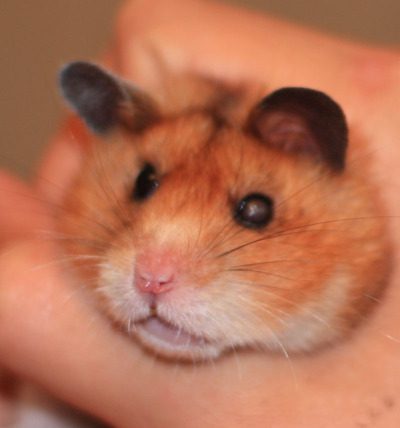 blindness. Eye drops are not effective, and surgery is not performed in either the Djungarian or the larger Syrian hamster. When the owner notices that the hamster’s eye has turned white, this is an occasion to see a doctor, despite the fact that there is no cure. A cataract in a hamster is a sign of old age, decrepitude of the body, and in a dzungarian or Campbell’s hamster it is an indirect sign of diabetes. In both cases, treatment of the underlying disease is required to prolong the life of the pet.
blindness. Eye drops are not effective, and surgery is not performed in either the Djungarian or the larger Syrian hamster. When the owner notices that the hamster’s eye has turned white, this is an occasion to see a doctor, despite the fact that there is no cure. A cataract in a hamster is a sign of old age, decrepitude of the body, and in a dzungarian or Campbell’s hamster it is an indirect sign of diabetes. In both cases, treatment of the underlying disease is required to prolong the life of the pet.
A thorn on the surface of the cornea is not a cataract, but the consequences of an injury, a scar. With a cataract, something bright is seen in the depths, in the pupil area.
Glaucoma
An increase in intraocular pressure is accompanied not only by an increase and bulging of the eyeballs, but also by severe pain. A doctor diagnoses glaucoma by measuring the pressure in the eye. It is not possible to normalize it with drops, the only treatment is enucleation to stop the pain. If nothing is done, the eye will eventually burst. It is difficult to say why such a pathology occurs. Since Campbell’s hamsters are most often sick, rarely Dzungarians and never Syrians, suggest a genetic (hereditary) nature.
Oncology
A small lump on a hamster’s eyelid may be a tumor. Cancer can also be the reason why one eye suddenly became larger than the other. Decorative rodents are prone to cancer and there is no effective treatment in such cases.
Conclusion
Even if you thoroughly know how to treat a hamster with an inflamed eye, do not neglect a visit to a specialist. In addition to wounds and infection, other problems must be ruled out. A ratologist will help you understand why the hamster’s eyes do not open: perhaps the eye itself is in order, but the cheek pouch is inflamed or there is a problem with the teeth (“flux”). Self-treatment is also unacceptable if the general condition worsens: if the animal is lethargic, its eyes are closed, and there is also leakage from the nose, the hamster probably got the “flu”, a respiratory infection.
Eye diseases in hamsters
3.4 (67.88%) 137 votes




